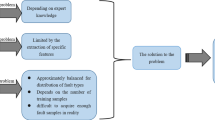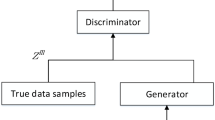Abstract
Intelligent fault diagnosis often requires a balanced dataset which is hard to be obtained in industrial equipments, often resulting in an imbalance between data in normal and data in the presence of faults. Data augmentation techniques are among the most promising approaches to mitigate such issue. Generative adversarial networks (GAN) are a type of generative model consisting of a generator module and a discriminator. Through adversarial learning between these modules, the optimised generator can produce synthetic patterns that can be used for data augmentation. We investigate the role of loss function in improving the training efficiency of GAN. We proposed a generalization of both mean square error (MSE GAN) and Wasserstein GAN with gradient penalty (WGAN-GP), referred to as VGAN (the V-matrix based GAN) to mitigate training instability. Also, we investigate the sliced Wasserstein distance (SWD) as the loss function of a cycle consistency generative adversarial network (CycleGAN), referred to as SW-CycleGAN. Both two models are evaluated on an industrial robot data set. Experimental results show that the proposed loss functions outperform other competitive models especially in terms of computational costs.
Access this chapter
Tax calculation will be finalised at checkout
Purchases are for personal use only
Similar content being viewed by others
References
Iqbal, J., Islam, R. U., Abbas, S. Z., Khan, A. A., & Ajwad, S. A. (2016). Automating industrial tasks through mechatronic systems-a review of robotics in industrial perspective. Tehnički vjesnik, 23(3), 917–924.
Caccavale, F., Cilibrizzi, P., Pierri, F., & Villani, L. (2009). Actuators fault diagnosis for robot manipulators with uncertain model. Control Engineering Practice, 17(1), 146–157.
Ali, J. B., Fnaiech, N., Saidi, L., Chebel-Morello, B., & Fnaiech, F. (2015). Application of empirical mode decomposition and artificial neural network for automatic bearing fault diagnosis based on vibration signals. Applied Acoustics, 89, 16–27.
Yan, K., Ji, Z., Lu, H., Huang, J., Shen, W., & Xue, Y. (2017). Fast and accurate classification of time series data using extended elm: Application in fault diagnosis of air handling units. IEEE Transactions on Systems, Man, and Cybernetics: Systems, 49(7), 1349–1356.
Goodfellow, I., Pouget-Abadie, J., Mirza, M., Xu, B., Warde-Farley, D., Ozair, S., Courville, A. C., & Bengio, Y. (2020). Generative adversarial networks. Communications of the ACM, 63(11), 139–144.
Zhang, S. (2022). On the nash equilibrium of moment-matching gans for stationary Gaussian processes. Ar**v, abs/2203.07136.
Premkumar, M., Jangir, P., Ramakrishnan, C., Nalinipriya, G., Alhelou, H. H., & Kumar, B. S. (2021). Identification of solar photovoltaic model parameters using an improved gradient-based optimization algorithm with chaotic drifts. IEEE Access, 9, 62347–62379.
Koziel, S., & Pietrenko-Dabrowska, A. (2021). Accelerated gradient-based optimization of antenna structures using multifidelity simulations and convergence-based model management scheme. IEEE Transactions on Antennas and Propagation, 69(12), 8778–8789.
Salimans, T., Goodfellow, I., Zaremba, W., Cheung, V., Radford, A., & Chen, X. (2016). Improved techniques for training gans. In: Advances in neural information processing systems (Vol. 29).
Lee, P. Y., Hui, S. C., & Fong, A. C. M. (2002). Neural networks for web content filtering. IEEE Intelligent Systems, 17(5), 48–57.
Kullback, S., & Leibler, R. A. (1951). On information and sufficiency. The Annals of Mathematical Statistics, 22(1), 79–86.
Arjovsky, M., Chintala, S., & Bottou, L. (2017). Wasserstein generative adversarial networks. In International Conference on Machine Learning (pp. 214–223). PMLR.
Levine, A., & Feizi, S. (2020). Wasserstein smoothing: Certified robustness against wasserstein adversarial attacks. In International Conference on Artificial Intelligence and Statistics (pp. 3938–3947). PMLR.
Donahue, J., & Krähenbühl, P., & Darrell, T. (2016). Adversarial feature learning. ar**v preprintar**v:1605.09782.
Yang, S., **e, L., Chen, X., Lou, X., Zhu, X., Huang, D., & Li, H. (2017). Statistical parametric speech synthesis using generative adversarial networks under a multi-task learning framework. In IEEE Automatic Speech Recognition and Understanding Workshop (ASRU) (pp. 685–691). IEEE.
Mirza, M., & Osindero, S. (2014). Conditional generative adversarial nets. Computing Research Repository, page ar**v:1411.1784.
Gulrajani, I., Ahmed, F., Arjovsky, M., Dumoulin, V., & Courville, A. C. (2017). Improved training of wasserstein gans. In Advances in neural information processing systems (Vol. 30).
Li, W., Zhong, X., Shao, H., Cai, B., & Yang, X. (2022). Multi-mode data augmentation and fault diagnosis of rotating machinery using modified acgan designed with new framework. Advanced Engineering Informatics, 52, 101552.
Mao, X., Li, Q., **e, H., Lau, R. Y., Wang, Z., & Paul Smolley, S. (2017). Least squares generative adversarial networks. In Proceedings of the IEEE International Conference on Computer Vision (pp. 2794–2802).
Lim, J. H., & Ye, J. C. (2017). Geometric gan. Ar**v, abs/1705.02894.
Miyato, T., Kataoka, T., Koyama, M., & Yoshida, Y. (2018). Spectral normalization for generative adversarial networks. CoRR, abs/1802.05957.
Tran, D., Ranganath, R., & Blei, D. (2017). Hierarchical implicit models and likelihood-free variational inference. In I. Guyon, U. Von Luxburg, S. Bengio, H. Wallach, R. Fergus, S. Vishwanathan, & R. Garnett (eds.), Advances in neural information processing systems (Vol. 30). Curran Associates, Inc.
Zhu, J. Y., Park, T., Isola, P., & Efros, A. A. (2017). Unpaired image-to-image translation using cycle-consistent adversarial networks. In Proceedings of the IEEE International Conference on Computer Vision (pp. 2223–2232).
Che, T., Li, Y., Jacob, A. P., Bengio, Y., & Li, W. (2016). Mode regularized generative adversarial.
Vapnik, V., & Izmailov, R. (2015). V-matrix method of solving statistical inference problems. Journal of Machine Learning Research, 16(51), 1683–1730.
Vapnik, V., & Izmailov, R. (2019). Rethinking statistical learning theory: learning using statistical invariants. Machine Learning, 108(3), 381–423.
Pu, Z., Cabrera, D., Li, C., & de Oliveira, J. V. (2022). VGAN: Generalizing MSE GAN and WGAN-GP for robot fault diagnosis. IEEE Intelligent Systems, 37(3), 65–75.
Nadjahi, K. (2021). Sliced-Wasserstein distance for large-scale machine learning: theory, methodology and extensions. Ph.D. thesis, Institut polytechnique de Paris.
Deshpande, I., Zhang, Z., & Schwing, A. (2018). Generative modeling using the sliced Wasserstein distance. 2018 IEEE/CVF Conference on Computer Vision and Pattern Recognition (CVPR) (pp. 3483–3491). Los Alamitos, CA, USA: IEEE Computer Society.
Zhao, K., Jiang, H., Liu, C., Wang, Y., & Zhu, K. (2022). A new data generation approach with modified wasserstein auto-encoder for rotating machinery fault diagnosis with limited fault data. Knowledge-Based Systems, 238, 107892.
Pu, Z., Cabrera, D., Li, C., & de Oliveira, J. V. (2023). Sliced wasserstein cycle consistency generative adversarial networks for fault data augmentation of an industrial robot. Expert Systems with Applications, 222, 119754.
Wang, J., Han, B., Bao, H., Wang, M., Chu, Z., & Shen, Y. (2020). Data augment method for machine fault diagnosis using conditional generative adversarial networks. Proceedings of the Institution of Mechanical Engineers, Part D: Journal of Automobile Engineering, 234(12), 2719–2727.
Balaji, Y., Min, M. R., Bai, B., Chellappa, R., & Graf, H. P. (2019). Conditional gan with discriminative filter generation for text-to-video synthesis. IJCAI, 1, 2.
Hu, T., Long, C., & **ao, C. (2021). A novel visual representation on text using diverse conditional gan for visual recognition. IEEE Transactions on Image Processing, 30, 3499–3512.
Dash, A., Gamboa, J. C. B., Ahmed, S., Liwicki, M., & Afzal, M. Z. (2017). Tac-gan - text conditioned auxiliary classifier generative adversarial network. CoRR, abs/1703.06412.
Gauthier, J. (2014). Conditional generative adversarial nets for convolutional face generation. In Class project for Stanford CS231N: Convolutional neural networks for visual recognition, Winter semester (Vol. 2014, no. 5, p. 2).
Gu, S., Bao, J., Yang, H., Chen, D., Wen, F., & Yuan, L. (2019). Mask-guided portrait editing with conditional gans. In Proceedings of the IEEE/CVF Conference on Computer Vision and Pattern Recognition (pp. 3436–3445).
Tang, H., Xu, D., Sebe, N., Wang, Y., Corso, J. J., & Yan, Y. (2019). Multi-channel attention selection gan with cascaded semantic guidance for cross-view image translation. In Proceedings of the IEEE/CVF Conference on Computer Vision and Pattern Recognition (pp. 2417–2426).
Bo Dai, Sanja Fidler, Raquel Urtasun, and Dahua Lin. Towards diverse and natural image descriptions via a conditional gan. In Proceedings of the IEEE International Conference on Computer Vision (pp. 2970–2979).
Wu, J., Wang, Y., Xue, T., Sun, X., Freeman, B., & Tenenbaum, J. (2018). 3d-aware scene manipulation via inverse graphics. In Advances in neural information processing systems (Vol. 31).
Yang, Z., Chen, W., Wang, F., & Xu, B. (2017). Improving neural machine translation with conditional sequence generative adversarial nets. ar**v preprintar**v:1703.04887.
Shapeev, V., Golushko, S., Belyaev, V., Bryndin, L., & Kirillov, P. (2021). New versions of the least-squares collocation method for solving differential and integral equations. Journal of Physics: Conference Series, 1715, 012031. IOP Publishing.
Kodali, N., Abernethy, J., Hays, J., & Kira, Z. (2018 .On convergence and stability of gans. In International Conference on Learning Representations.
Freirich, D., Michaeli, T., & Meir, R. (2021). A theory of the distortion-perception tradeoff in wasserstein space. Advances in Neural Information Processing Systems, 34.
Piradl, S., & Shadrokh, A. (2021). Robust minimum distance estimation of a linear regression model with correlated errors in the presence of outliers. Communications in Statistics-Theory and Methods, 50(23), 5488–5498.
Deshpande, I., Zhang, Z., & Schwing, A. G. (2018). Generative modeling using the sliced wasserstein distance. In Proceedings of the IEEE Conference on Computer Vision and Pattern Recognition (pp. 3483–3491).
Lee, C. Y., Batra, T., Baig, M. H., & Ulbricht, D. (2019). Sliced wasserstein discrepancy for unsupervised domain adaptation. In Proceedings of the IEEE/CVF Conference on Computer Vision and Pattern Recognition (pp. 10285–10295).
Nadjahi, K., Durmus, A., Jacob, P. E., Badeau, R., & Simsekli, U. (2021). Fast approximation of the sliced-wasserstein distance using concentration of random projections. Advances in Neural Information Processing Systems, 34.
Tang, H., Liu, H., Xu, D., Torr, P. H., & Sebe, N. (2021). Attentiongan: Unpaired image-to-image translation using attention-guided generative adversarial networks. IEEE Transactions on Neural Networks and Learning Systems.
Lu, Y., Tai, Y. W., & Tang, C. K. (2018). Attribute-guided face generation using conditional cyclegan. In Proceedings of the European Conference on Computer Vision (ECCV) (pp. 282–297).
He, K., Zhang, X., Ren, S., & Sun, J. (2016). Deep residual learning for image recognition. In Proceedings of the IEEE Conference on Computer Vision and Pattern Recognition (pp. 770–778).
Hu, J., Shen, L., & Sun, G. (2018). Squeeze-and-excitation networks. In Proceedings of the IEEE Conference on Computer Vision and Pattern Recognition (pp. 7132–7141).
Demsar, J. (2006). Statistical comparisons of classifiers over multiple data sets. Journal of Machine Learning Research, 7, 1–30.
Pacheco, F., de Oliveira, J. V., Sánchez, R. V., Cerrada, M., Cabrera, D., Li, C., Zurita, G., & Artés, M. (2016). A statistical comparison of neuroclassifiers and feature selection methods for gearbox fault diagnosis under realistic conditions. Neurocomputing, 194, 192–206.
Cabrera, D., Sancho, F., Long, J., Sánchez, R. V., Zhang, S., Cerrada, M., & Li, C. (2019). Generative adversarial networks selection approach for extremely imbalanced fault diagnosis of reciprocating machinery. IEEE Access, 7, 70643–70653.
Han, Y., Liu, S., Cong, D., Geng, Z., Fan, J., Gao, J., & Pan, T. (2021). Resource optimization model using novel extreme learning machine with t-distributed stochastic neighbor embedding: Application to complex industrial processes. Energy, 225, 120255.
Acknowledgements
This work is supported in part by Portuguese funds through FCT-Foundation for Science and Technology, in part by I.P., through IDMEC, under LAETA Project UIDB/50022/2020, in part by the National Natural Science Foundation of China under Grant 52175080, in part by the Chongqing Natural Science Foundation under Grant cstc2019jcyj-zdxmX0013, in part by the Guangdong Basic and Applied Basic Research Foundation under Grant 2019B1515120095, and in part by the Intelligent Manufacturing PHM Innovation Team Program under Grant 2018KCXTD029.
Author information
Authors and Affiliations
Corresponding author
Editor information
Editors and Affiliations
Rights and permissions
Copyright information
© 2024 The Author(s), under exclusive license to Springer Nature Switzerland AG
About this chapter
Cite this chapter
Pu, Z., Li, C., de Oliveira, J.V. (2024). On the Effect of Loss Function in GAN Based Data Augmentation for Fault Diagnosis of an Industrial Robot. In: Lyu, Z. (eds) Applications of Generative AI. Springer, Cham. https://doi.org/10.1007/978-3-031-46238-2_16
Download citation
DOI: https://doi.org/10.1007/978-3-031-46238-2_16
Published:
Publisher Name: Springer, Cham
Print ISBN: 978-3-031-46237-5
Online ISBN: 978-3-031-46238-2
eBook Packages: Computer ScienceComputer Science (R0)




